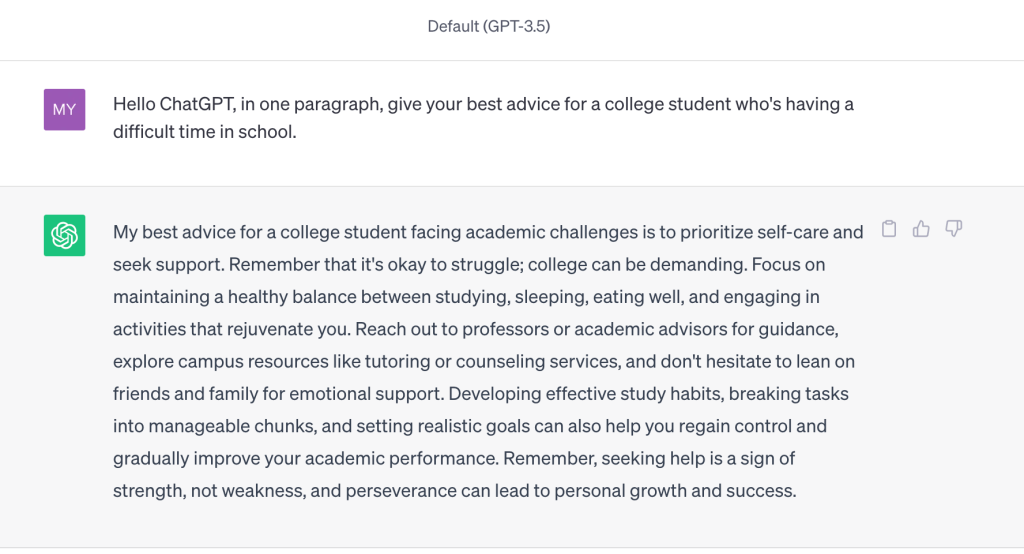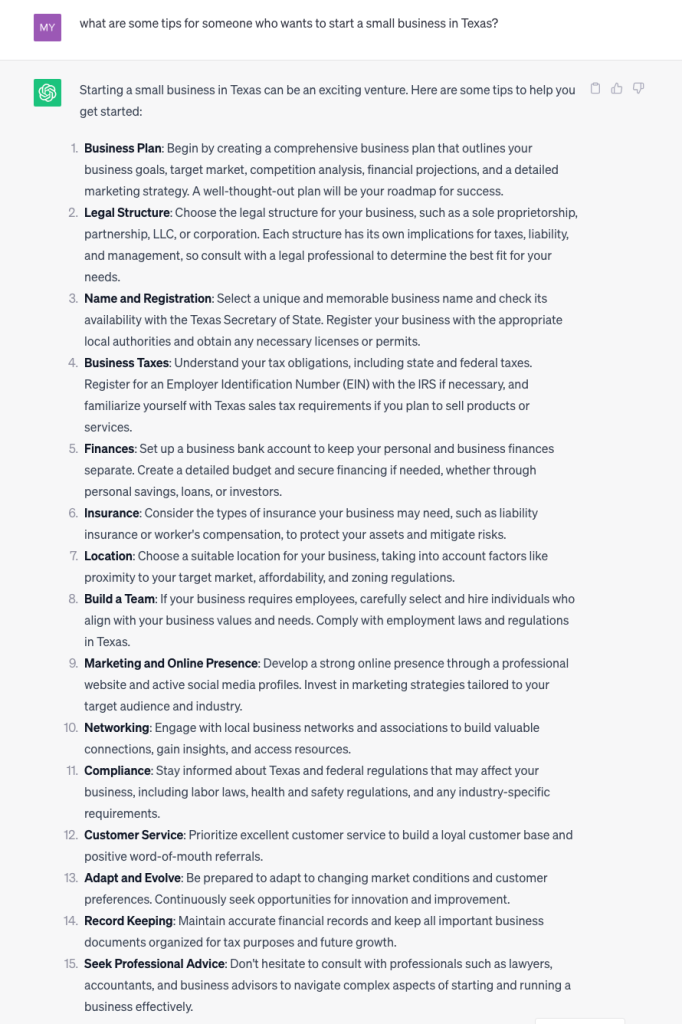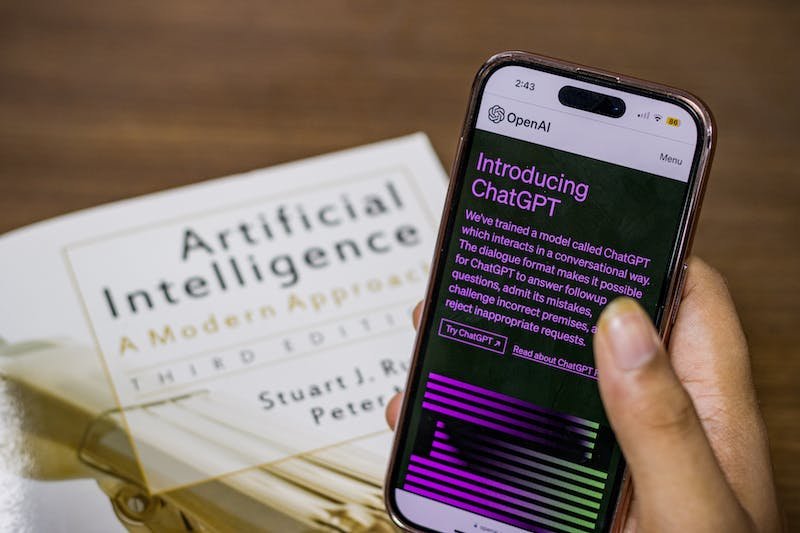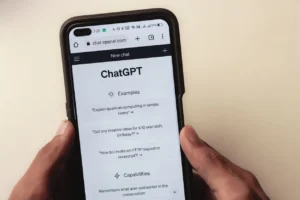A comprehensive introduction to ChatGPT: The industry-leading innovative Artificial Intelligence Chatbot by OpenAI.
One of the record-breaking launches in human history is ChatGPT, the number of signups during the first few days it was announced took the internet by storm and left many people wondering what is ChatGPT built with and what’s the purpose. The launch drew a lot of attention including security concerns and that’s why it is yet to be unblocked in some parts of the world to date.
So, if you’ve heard people talk about ChatGPT in college, your place of work, on YouTube, or on social media, you must be wondering what exactly is ChatGPT and how to get started using it. That’s why we’ve prepared this ChatGPT for beginners guide to help you understand more about OpenAI ChatGPT with prompt examples, sign-up, and login guides.
What Is ChatGPT?
ChatGPT is an AI-powered chatbot that uses natural language processing (NLP) to communicate with users. It is designed to simulate human conversation and provide helpful responses to user queries and requests.
The technology behind ChatGPT is based on the GPT (Generative Pre-trained Transformer) model, which is a type of neural network that has been trained on vast amounts of text data. This training enables ChatGPT to understand and respond to a wide range of user inputs, including questions, statements, and commands.
ChatGPT can be used for a variety of purposes, including customer service, personal assistance, and entertainment. It can be integrated into websites, messaging apps, and other platforms to provide users with a seamless and personalized experience.
The strength of ChatGPT can be traced back to the implementation of natural language processing (NLP) technology and a humongous data set for giving users responses. The NPL technology allows computers to understand and interpret human language, making it possible for chatbots like ChatGPT to communicate with users in a natural and intuitive way. As NLP technology continues to advance, it is likely that we will see even more sophisticated chatbots in the future.
Key Takeaways
- ChatGPT is a cloud-based AI chatbot developed by OpenAI.
- ChatGPT is a user-friendly chatbot that uses artificial intelligence to communicate with users and provide them with information.
- ChatGPT is based on natural language processing (NLP) technology, which allows computers to understand and interpret human language.
- ChatGPT requires account creation and sign-in to access and make use of the chatbot.
- There’s a free version of ChatGPT and ChatGPT Plus which is the paid version.
- While ChatGPT has many advantages, it is still limited by the quality of its training data and may struggle with complex or nuanced language.
The Origin Of ChatGPT
How ChatGPT started can be traced back to OpenAI’s ongoing research and development in the fields of natural language processing and artificial intelligence. It is part of a series of models that began with the original GPT (Generative Pre-trained Transformer) and evolved through subsequent iterations.
Here’s a brief timeline of the key developments leading to ChatGPT latest version from its early stages to date:
- GPT-1 (June 2018): OpenAI introduced the first version of the GPT model. GPT-1 was a significant advancement in natural language processing, as it demonstrated the effectiveness of pre-training large neural networks on a vast amount of text data.
- GPT-2 (February 2019): GPT-2 was a larger and more capable version of the model. Initially, OpenAI expressed concerns about the potential misuse of the model due to its ability to generate human-like text. However, they later released it to the public.
- GPT-3 (June 2020): GPT-3 was a major breakthrough in AI language models. It was even more massive and capable than GPT-2, with 175 billion parameters. GPT-3 gained widespread attention for its ability to perform a wide range of natural language understanding and generation tasks, including chatbot applications.
- GPT-3.5 (2022): “GPT-3.5” is a term sometimes used to refer to an evolved version of GPT-3, which incorporates enhancements, fine-tuning, and updates to improve its performance and capabilities in conversational applications. This is the model commonly referred to as ChatGPT.
- GPT-4.0 (March 2023): ChatGPT 4.0 is the most advanced version of OpenAI ChatGPT that comes with ChatGPT Plus subscription feature and it’s currently available to premium users only.
OpenAI’s research and development efforts in AI language models have been instrumental in the creation and evolution of ChatGPT. These models are typically trained on vast datasets from the internet, books, and they are fine-tuned for specific tasks and use cases to improve their ability to understand and generate human-like text in a conversational context. ChatGPT represents one of the most advanced iterations of these models, designed to excel in chatbot and conversational AI applications.
How Does ChatGPT Work?
ChatGPT is an AI-based chatbot that uses natural language processing and machine learning algorithms to understand and respond to user queries. It is designed to simulate human-like conversations and provide helpful responses to users.
When a user inputs a query, ChatGPT first analyzes the text to understand the intent and context of the question. It then uses its machine learning algorithms to search its database of information and generate a response that best matches the user’s query.
ChatGPT is constantly learning and improving its responses based on user interactions and feedback. It uses deep learning algorithms to analyze user feedback and adjust its responses to provide more accurate and helpful answers.
ChatGPT can be used to answer a wide range of questions on various topics, such as general knowledge, news, entertainment, science, technology, and more. It is available 24/7 and can be accessed from any device with an internet connection.
The following sub-sections explain how ChatGPT works in detail.
Natural Language Processing
ChatGPT uses NLP to understand human language. It analyzes the input text and converts it into a structured format that can be processed by the ML algorithms. NLP helps ChatGPT to identify the intent of the user and extract relevant information from the text.
NLP enables ChatGPT to understand complex sentences, idioms, and colloquialisms. It also helps the system to recognize the context of the conversation and provide appropriate responses. ChatGPT uses advanced NLP techniques such as sentiment analysis, entity recognition, and part-of-speech tagging to enhance its understanding of human language.
Machine Learning
ChatGPT uses ML to learn from the input data and improve its performance over time. The system is trained on a large dataset of conversations, which helps it to identify patterns and generate accurate responses.
ML enables ChatGPT to generate responses that are contextually relevant and grammatically correct. The system uses deep learning algorithms such as neural networks to generate responses that are similar to human-generated text. ChatGPT also uses reinforcement learning to improve its conversational abilities over time.
What Is ChatGPT Used For?
The following subsections explain what ChatGPT can be used for. However, this is just to mention a few of ChatGPT applications.
Education
ChatGPT can be used in the education sector to provide personalized learning experiences to students. With its ability to understand natural language, ChatGPT can engage in conversations with students, answer their questions, and provide them with explanations in a way that is easy to understand. It can also assist teachers in creating lesson plans and generating quizzes and tests.
Business
ChatGPT can also be used in the business sector to improve customer service. It can be integrated into websites or mobile apps to provide customers with instant support. ChatGPT can answer frequently asked questions, provide product recommendations, and help customers make purchases. It can also analyze customer data to provide insights that can help businesses improve their products and services.
Entertainment
ChatGPT can be used in the entertainment industry to create interactive experiences for users. It can be used to create chatbots that can engage in conversations with users, answer their questions, and provide them with recommendations for movies, TV shows, or music. ChatGPT can also be used to create virtual assistants that can help users manage their media libraries and discover new content.
In our next guides, we will teach you how to monetize ChatGPT to give yourself and your business an incredible 10X boost.
Advantages Of Using ChatGPT
ChatGPT is an AI-powered chatbot that offers a range of benefits to its users. Here are some advantages of using ChatGPT:
1. 24/7 Availability
One of the biggest advantages of ChatGPT is its 24/7 availability. Users can access the chatbot anytime, anywhere, without any constraints of time or location. This means that users can get their queries resolved or problems solved quickly and efficiently, without having to wait for customer support to open.
2. Quick and Accurate Responses
ChatGPT uses AI and natural language processing (NLP) to understand user queries and provide quick and accurate responses. The chatbot can handle multiple queries simultaneously and respond to them in real time, making it an efficient and effective tool for businesses.
3. Cost-Effective
ChatGPT is a cost-effective solution for businesses that want to provide 24/7 customer support without hiring additional staff. The chatbot can handle a large volume of queries at once, reducing the need for human intervention and saving businesses money in the long run.
4. Personalized Experience
ChatGPT can provide a personalized experience to its users by analyzing their interactions and preferences. The chatbot can use this data to provide personalized recommendations, suggestions, and solutions, making the user experience more engaging and satisfying.
5. Scalability
ChatGPT is a scalable solution that can handle a large volume of queries and users without any performance issues. This makes it an ideal tool for businesses that want to expand their customer support operations without worrying about infrastructure or resource constraints.
Overall, ChatGPT is a powerful and versatile tool that can provide a range of benefits to businesses and users alike.
Limitations Of ChatGPT
While ChatGPT is an impressive AI model that can generate human-like responses to a wide range of prompts, it still has some limitations. Here are a few of the most notable ones:
1. Lack of contextual understanding
ChatGPT doesn’t have a full understanding of the context of a conversation, which can lead to some awkward or nonsensical responses. For example, if a user asks a question that’s related to a specific topic, ChatGPT may not be able to provide a relevant answer if it hasn’t been trained on that topic.
2. Repetitive responses
Another limitation of ChatGPT is that it can sometimes provide repetitive responses. This is because the model generates its responses based on patterns it has learned from the text it has been trained on. If it encounters a prompt that’s similar to one it has seen before, it may produce a similar response, even if that response isn’t entirely appropriate for the new context.
3. Lack of emotional intelligence
ChatGPT also lacks emotional intelligence, which means it can’t detect the emotional tone of a conversation or respond appropriately to emotional cues. This can make it difficult for the AI to provide empathetic or supportive responses in certain situations.
4. Potential for bias
Finally, like all AI models, ChatGPT has the potential to exhibit bias based on the data it has been trained on. If the training data contains biased language or perspectives, ChatGPT may inadvertently reproduce those biases in its responses. This is a significant concern for AI developers and researchers, who are working to ensure that AI models like ChatGPT are as unbiased as possible.
The Future Of ChatGPT
ChatGPT has already made significant strides in the fields of chatbots and natural language processing. The future of ChatGPT looks promising, with the potential for even more advancements and improvements to be made.
One area where ChatGPT could see further development is in its ability to understand and interpret emotions. As chatbots become more sophisticated, they will need to be able to recognize and respond appropriately to human emotions. ChatGPT could be used to develop more emotionally intelligent chatbots that can provide better support and assistance to users.
Another area where ChatGPT could see further development is in its ability to expand its multiple language features. As businesses and organizations become more global, there is an increasing need for chatbots that can communicate effectively in multiple languages. ChatGPT could be used to develop chatbots that can seamlessly switch between languages and provide support to users in their native language.
How To Use ChatGPT
To use ChatGPT, you will have to create an account on the OpenAI platform and log in each time you want to access and make use of the Chatbot.
Immediately you’re logged in, you can start sending questions (prompts) to ChatGPT to get human-like responses from this wonderful innovative Artificial Intelligence chatbot. ChatGPT can be accessed via a web browser or through ChatGPT mobile apps.
We will show you some examples of ChatGPT prompts to help you get started, as well as the responses generated by ChatGPT.
ChatGPT prompt examples and responses
See the screenshots below for the prompts we sent out and the responses generated by ChatGPT.
We asked ChatGPT for advice for a college student going through difficulties and asked that the advice come in one paragraph.
Prompt example: “Hello ChatGPT, in one paragraph, give your best advice for a college student who’s having a difficult time in school.”
See the response generated below:

We asked ChatGPT for some business tips for someone who wants to start a small business in Texas, using the prompt below:
ChatGPT prompt example: “What are some tips for someone who wants to start a small business in Texas?”
See the ChatGPT-generated response below:

Interestingly, you can ask ChatGPT questions in your own way and get a response. It is important to note that the quality of the response you get from ChatGPT depends on your given prompt, how clear you make it, and how ChatGPT understands it.
You can copy and paste any of our ChatGPT prompt examples to see the output you will get. ChatGPT is good at giving answers to the same questions in unique ways, also feel free to modify them further to suit you.
To personalize your chat with ChatGPT, you can also tell ChatGPT your name and get mentioned where appropriate in the responses.
What information is ChatGPT trained on?
Where does ChatGPT get its information? The incredible works of ChatGPT have made many begin to ask what information is this innovative AI chatbot built by OpenAI trained on?
ChatGPT we all know is a generative AI that generates human-like responses for it’s registered users, it can be used for a variety of purposes including data analysis. With the recent development in ChatGPT, users can now speak to ChatGPT and get read-aloud responses, ChatGPT has also gone out of only text-based responses and can generate images, access inputs as an image upload method, and many more.
The way ChatGPT generates responses was primarily dependent on the data it was trained on, which was cut off in 2021. Recently, the OpenAI company announced that ChatGPT can also give responses in real time this means that ChatGPT as a Large Language Model that was trained on a huge amount of data set, will no longer rely only on the data set it is trained on, to provide information to its users. This update is to better the experiences of ChatGPT users to get answers for almost everything in real-time.
So, we will deeply look into the information ChatGPT is trained on that gives it so much power to respond to millions of people and provide unique answers to individuals even if their questions are similar or the same.
The information ChagtGPT is trained on heavily depends on the following;
Books
Books contribute to ChatGPT’s large collection of text data. This is made possible since the most popular books can also be accessed online through their digital formats in libraries.
User Feedback
When you interact with ChatGPT and give feedback on the responses it generates to signify whether it was helpful or not, OpenAI puts your feedback into consideration to improve the AI chatbot and better your experience.
Plugins
ChatGPT leverages the data set for installed plugins to serve you better. If you installed a trip suggestion plugin, ChatGPT can easily access the trip suggestion plugin’s data to give you the best result for your query.
User input
ChatGPT is capable of learning from your corrections and can make amendments immediately to give you a better answer. Now that ChatGPT supports the upload of images, the information it provides relies on the image you provided, and by so doing, you’re training ChatGPT with your own data and it will generate a response for you based on the information you provided.
Internet
The new feature of ChatGPT allows ChatGPT to go beyond the 2021 cut of training data. ChatGPT can now generate responses from information available on the internet in real time with proper citations for the sources the information was curled from.
ChatGPT Demo – everything you need to know
The search for ChatGPT demo is on the increase since OpenAI made ChatGPT accessible only to registered users who are signed in. Despite the fact that ChatGPT signup and login process takes a few minutes to complete, it’s obvious how a great number of persons are on the search for how to bypass ChatGPT login or phone number verification.
The truth is that there’s no official ChatGPT demo for anyone, if you want to use ChatGPT for free, you can sign up at chat.openai.com or follow the easy guide here. It is also important to mention that the ChatGPT 4 demo is not real as there’s no such thing. People who want to get their first experience using ChatGPT will have to sign up for it and pay when they want to upgrade to ChatGPT Pro, also known as ChatGPT Plus.
ChatGPT Overview
| Name | ChatGPT |
| Developer | Natural Language Understanding and human-like text generation. |
| Platform | Cloud computing platforms. |
| Mobile apps | Yes, Android and iOS. |
| ChatGPT website address | chat.openai.com. |
| Architecture | GPT 3.5 (free version) GPT 4.0 (ChatGPT Plus, paid version) |
| Purpose | Natural Language understanding and human-like text generation. |
| Data trained on | Large data set from the internet and books. |
| CEO | Sam Altman. |
| Support email | Support@openai.com |
| Parent company | Openai.com. |
| License type | Proprietary. |
| Programming language | Python |
FAQs
Is ChatGPT better than Google?
They’re two different entities, ChatGPT is an AI chatbot, while Google is a search engine. They have different functions, Google is best for generating results in real-time from different sources, which include images, texts, audio, and videos, while ChatGPT generates human-like responses based on a given prompt and relies solely on the data set it’s trained on.
Does ChatGPT have an app?
Yes, ChatGPT has both Android and iOS apps, which can be downloaded from the respective app stores.
Can ChatGPT replace Google?
No, ChatGPT is a language model and was primarily built to assist humans with generative text responses, while Google is a search engine. ChatGPT is not a threat to Google and has not made any official announcement about its plan to compete with Google.
How many people are using ChatGPT?
ChatGPT has reached over 100 million users and is still counting. More than 50% of the population on ChatGPT are men, and the rest are women.
How much does it cost to run ChatGPT a day?
It costs $700,000/day to run ChatGPT, this was revealed by SemiAnalysis earlier this month.
Who invented ChatGPT?
OpenAI invented ChatGPT in 2019, and no single person owns ChatGPT. Sam Alman is the current CEO and co-founder of ChatGPT.
Which jobs will ChatGPT eliminate?
Although ChatGPT wasn’t built to replace any specific type of job, it’s obvious that the people ChatGPT will replace are people who are not adopting the use of AI and advancing their skills in their various fields. ChatGPT can be used to improve your skills and boost your productivity. That you can remain relevant in your industry.
What type of content can ChatGPT help you create?
ChatGPT can help you create any text-based content. Be it a blog post, movie script, essay, poem, joke, etc.
Where is the headquarters of ChatGPT?
ChatGPT is located in San Francisco, California, in the United States of America.
What kind of questions can you ask on ChatGPT?
There’s no limit to the kind or number of questions you can ask ChatGPT as it is trained on a very large data set. It has the ability to answer a variety of questions and will also let you know when you ask a question outside its trained data set. You can ask ChatGPT trivia questions or advice, ask ChatGPT to tell a story, you can ask ChatGPT maths questions, etc.
Why is it called ChatGPT?
It is called ChatGPT, which stands for “Chat Generative Pre-trained Transformer,” because it’s a natural language model with generative text abilities.
Does ChatGPT store your data?
Yes, ChatGPT stores your data, from your sign-on information to your chat history, as those chat histories can also be used for training and improving the chatbot to serve you better.
Can ChatGPT conversations be deleted?
Yes, you can simply click on the chat entry on the left side of the screen and then click on the delete icon to trash your conversation with ChatGPT.
What can replace ChatGPT?
ChatGPT competitors are; Google Bard AI, Bing AI, Poe AI, YouChat, and Chatsonic.
Does ChatGPT take data from Google?
ChatGPT does not rely on Google to generate its responses, while ChatGPT can now browse the internet, it has the ability to navigate through web pages and provide the information required with proper citation of its sources.
What language was ChatGPT trained on?
ChatGPT is primarily written in Python programming language.
how many questions can you ask ChatGPT in an hour?
How many requests you can ask ChatGPT in an hour for free depends on a number of factors such as the length of your request, the server status at the moment, and the number of other users sending requests at the same time. However, ChatGPT can answer hundreds of questions in an hour under normal circumstances. ChatGPT Plus has an unlimited number of requests.
Conclusion
Despite its many advantages, ChatGPT is not without its limitations. While it is capable of understanding and responding to a wide range of queries, it is still limited by the quality of its training data. Additionally, it may struggle to understand complex or nuanced language, which can lead to misunderstandings or errors. Nevertheless, ChatGPT remains a powerful tool for businesses and individuals looking to improve their communication and productivity.
Finally, ChatGPT could be used to develop chatbots that are more personalized and tailored to individual users. By analyzing data on user behavior and preferences, chatbots could be customized to provide more relevant and useful information to each user. This could lead to a more satisfying user experience and increased engagement with chatbots.
The future of ChatGPT looks bright, with the potential for further advancements and improvements in the field of chatbots and natural language processing.






